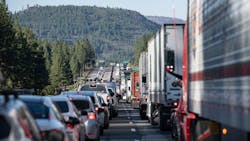Bottlenecks, infrastructure undermine alternative fuel trucks
For the past 12 years, the American Transportation Research Institute (ATRI) has published a report on the top truck bottlenecks by monitoring more than 300 critical freight locations. Bottlenecks slow down trucks and make the movement of goods inefficient. Bottlenecks cost money and add to emissions as trucks sit and wait to move.
See also: ATRI reveals top truck bottlenecks for 2023
The most recent rating of the U.S. infrastructure from the American Society of Civil Engineers is a C-. This is an obvious problem and needs to be addressed. The safety of all drivers is at stake.
The C- grade is bad enough, but over the next several decades, we are going to expect our infrastructure to do even more. As we move toward alternative fuel vehicles, we will need charging and fueling stations for electric vehicles or those using hydrogen or natural gas. It can take more time to charge an EV than it does to fuel a diesel truck. As a result, we will need to build more charging stations with more parking spaces for trucks. Truck parking is already a big problem in the industry.
The fact that we can’t keep the infrastructure needed by diesel-powered trucks in better than a C- condition makes me concerned about whether we will be able to meet the infrastructure demands of new powertrains.
See also: Charging infrastructure holds back EV truck production, deployment
In addition, autonomous vehicle technology is moving at a rapid pace, and autonomous vehicles need to be able to “see” lane and edge markings to operate safely. Not every road has “readable” edge and lane markings. Autonomous vehicles will require a major upgrade to our infrastructure.
Local, state, and federal agencies need to begin work today to bring up that C- grade. We need to begin working on making improvements now, starting in the most heavily traveled freight corridors and in the areas where the congestion bottlenecks are the most severe.
If we don’t improve the infrastructure, the freight efficiency gains and emissions reductions we hope to get from these cleaner fuels will not be fully realized.
Patrick Gaskins, SVP of Corcentric Fleet Solutions, oversees both sales and operations for the company's fleet offerings. Gaskins joined the company in 2010, bringing more than 30 years of experience as a financial services professional in the transportation industry. He leads a team that works with a supply base of more than 160 manufacturers to help the country’s largest fleets manage all aspects of their fleet operations and fleet-related spending.
About the Author

Patrick Gaskins
Senior vice president, Fleet Solutions
Pat Gaskins is the senior vice president of Corcentric Fleet Solutions, where he leads both the sales and operations teams for the company’s fleet offerings. He has over 30 years of experience as a financial services professional in the transportation industry and manages partnerships with over 160 manufacturers, helping over 2,000 of the country’s largest fleets manage all aspects of their fleet operations and fleet-related spend.
